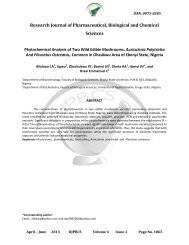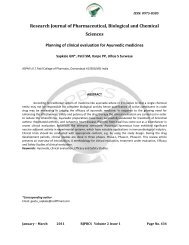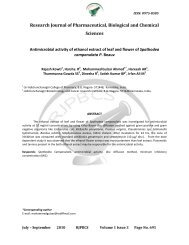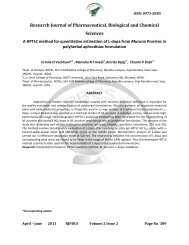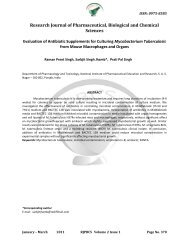A Pharmacognostic and Pharmacological Overview on Caesalpinia
A Pharmacognostic and Pharmacological Overview on Caesalpinia
A Pharmacognostic and Pharmacological Overview on Caesalpinia
Create successful ePaper yourself
Turn your PDF publications into a flip-book with our unique Google optimized e-Paper software.
ISSN: 0975-8585<br />
previous report, we could not detect any hypoglycaemic activity in the seeds of <strong>Caesalpinia</strong><br />
b<strong>on</strong>ducella growing in Dar es Salaam [66].<br />
Biswas T.K. et al., reported oral hypoglycemic effect of <strong>Caesalpinia</strong> b<strong>on</strong>ducella. The<br />
blood sugar lowering efficacy of the aqueous extract of <strong>Caesalpinia</strong> b<strong>on</strong>ducella F. (seed shell)<br />
was evaluated in fasted, fed, glucose loaded, streptozotocin diabetic, <str<strong>on</strong>g>and</str<strong>on</strong>g> alloxan diabetic rat<br />
models. The extract was administered orally at a dose of 250 mg/kg of rat body weight. It<br />
produced very significant blood sugar lowering (at least P < 0.005) in glucose loaded,<br />
streptozotocin diabetic, <str<strong>on</strong>g>and</str<strong>on</strong>g> alloxan diabetic models. However, effects were not so pr<strong>on</strong>ounced<br />
in fasted <str<strong>on</strong>g>and</str<strong>on</strong>g> fed models. As a whole, <strong>Caesalpinia</strong> b<strong>on</strong>ducella can be regarded as a good oral<br />
hypoglycemic agent in rat [67].<br />
Muscle c<strong>on</strong>tractile activity<br />
Datté JY, et al., Leaf extract of <strong>Caesalpinia</strong> b<strong>on</strong>duc Roxb. induces an increase of<br />
c<strong>on</strong>tractile force in rat skeletal muscle in situ. The pharmacological properties of <strong>Caesalpinia</strong><br />
b<strong>on</strong>duc Roxb. are not well known, but it is used traditi<strong>on</strong>ally to treat snake bite. In the present<br />
study, the mechanism through which <strong>Caesalpinia</strong> b<strong>on</strong>duc extract (Cebo) affects gallamineinduced<br />
relaxati<strong>on</strong> in rat tibial muscle c<strong>on</strong>tractility were studied via measurement of isometrictensi<strong>on</strong>-anesthetized,<br />
10-12-week-old, male rats. Isometric twitch c<strong>on</strong>tracti<strong>on</strong>s of the<br />
indirectly-stimulated anterior tibia muscle of the right hindleg were recorded in situ. Cebo<br />
administered intravenously increased twitch c<strong>on</strong>tracti<strong>on</strong>s in a dose-dependent manner. The<br />
ED50 value is 2.75 x 10(-4) g/kg body wt. Similar results were obtained using the<br />
anticholinesterase neostigmine. In c<strong>on</strong>trast, gallamine (a n<strong>on</strong>-depolarizing muscle relaxant) or<br />
the venom of the puff adder Bitis arietans reduced the force of c<strong>on</strong>tracti<strong>on</strong>. Treatment with<br />
Cebo or neostigmine, however, reversed the relaxati<strong>on</strong> induced by either gallamine or puff<br />
adder venom. In c<strong>on</strong>clusi<strong>on</strong>, Cebo stimulates the muscle c<strong>on</strong>tractile activity, an effect which<br />
may be due to an activati<strong>on</strong> of the cholinergic mechanism [68].<br />
Datté JY, et al., reprted effects of leaf extract of <strong>Caesalpinia</strong> b<strong>on</strong>duc <strong>on</strong> the c<strong>on</strong>tractile<br />
activity of uterine smooth muscle of pregnant rats. The calcium dependency <str<strong>on</strong>g>and</str<strong>on</strong>g> the cholinergic<br />
effect of the leaf extract of <strong>Caesalpinia</strong> b<strong>on</strong>duc Roxb. was studied in isolated pregnant rat<br />
myometrium preparati<strong>on</strong>s. Isometric c<strong>on</strong>tracti<strong>on</strong>s were recorded. The extract (Cebo) increased<br />
the c<strong>on</strong>tractile force in the isolated strips in a c<strong>on</strong>centrati<strong>on</strong>-dependent manner. The effects<br />
were comparable to those obtained with acetylcholine. C<strong>on</strong>tracti<strong>on</strong>s induced by Cebo or<br />
acetylcholine were inhibited in the presence of atropine. The stimulating acti<strong>on</strong> of Cebo <strong>on</strong> the<br />
c<strong>on</strong>tractile resp<strong>on</strong>ses of isolated myometrium preparati<strong>on</strong>s inhibited by atropine may be<br />
mediated by cholinergic receptors. In calcium-free soluti<strong>on</strong> Cebo induced a t<strong>on</strong>ic c<strong>on</strong>tracti<strong>on</strong><br />
(c<strong>on</strong>tracture) of the muscle. Moreover, in high-potassium calcium-free soluti<strong>on</strong> Cebo caused<br />
c<strong>on</strong>tracture of the uterine smooth muscle. Cebo was still able to elicit c<strong>on</strong>tracti<strong>on</strong>s in calciumfree<br />
soluti<strong>on</strong> c<strong>on</strong>taining EDTA or EGTA. These findings suggest the existence of cholinergic<br />
receptors sensitive to Cebo which could influence the influx of calcium (phasic c<strong>on</strong>tracti<strong>on</strong>) <str<strong>on</strong>g>and</str<strong>on</strong>g><br />
mobilizati<strong>on</strong> of calcium from cellular stores (t<strong>on</strong>ic c<strong>on</strong>tracti<strong>on</strong>), both of which are resp<strong>on</strong>sible<br />
January – March 2012 RJPBCS Volume 3 Issue 1 Page No. 490



